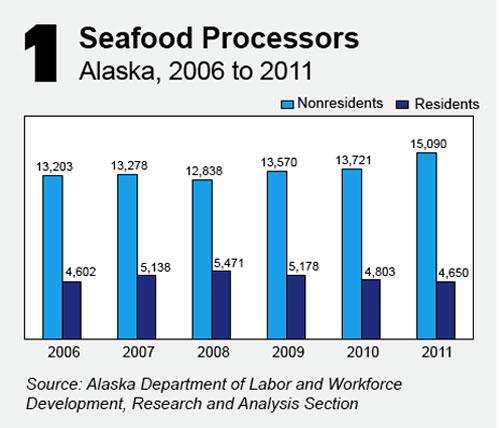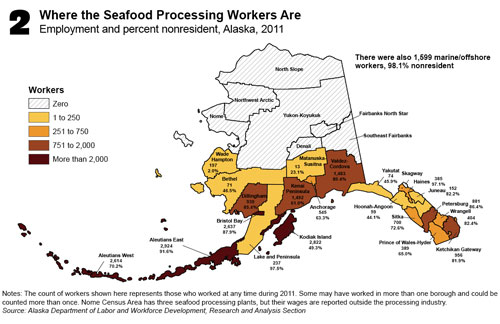
Long Hours on the ‘Slime Line’
Seafood processors key to Alaska’s largest export
By By ERIK STIMPFLE, Research Analyst
November 02, 2012
Friday PM
(SitNews) - Seafood is one of Alaska’s most lucrative natural resources — and with Alaska fishermen bringing in more than half of the country’s poundage, it takes an enormous workforce to bring the product to market. Seafood processors are the largest share of workers in the fishing industry and also the largest group of seasonal workers in the state.
Processors must be physically fit and able to work long and repetitive hours in wet and slippery conditions. Their duties — which require rain gear, gloves, and boots — can include sorting, grading, washing, cutting, or trimming seafood. The work is sometimes by machine, but often by hand.
This job may not be glamorous — it’s often called the “slime line” — but it’s a critical step in a major supply chain.

A large, mobile workforce
The seafood processing industry provides mostly seasonal jobs wherever there is commercial fishing. The various fisheries span the calendar, and facilities are spread across the state.
Though most salmon species are harvested during the summer only, various shellfish, cod, and bottom fish are harvested throughout the year. The processing industry as a whole employed 25,112 workers statewide in 2011. Of those workers, 19,740 were seafood processors.
The areas with the biggest catches also have the highest employment. The Aleutians East and Aleutians West census areas and Bristol Bay and Kodiak boroughs each had more than 2,600 processors in 2011. Together, those areas employed 51 percent of the industry’s workers.

Click on the image for a larger view.
The industry relies on widespread recruiting to ensure they will have an adequate number of workers when it’s time to process the fish, and they hire thousands for short periods of time. To meet the annual need, the largest employers host hiring events across the United States, which means a large pool of new workers each year. During 2011, more than 10,000 seafood processors were new hires, defi ned as those who didn’t work for their current employer in any of the previous four quarters.
In 2011, 76.4 percent of seafood processors were nonresidents — much higher than any other occupation. In the industry as a whole, 72.8 percent of workers were not Alaska residents. (Residency is determined by a match with the two most recent Permanent Fund Dividend applicant files. Data may not be comparable with the Nonresidents Working in Alaska publication due to differences in methodology.)
The rate of nonresident hire varies widely by area, though. In Kodiak Island Borough, 49.3 percent of its 2,822 processors were nonresidents in 2011 — a sharp contrast to 91.6 percent in Aleutians East. Remote facilities such as those in Aleutians East have a greater need for nonresident workers because there isn’t a large enough pool of locals to fill the jobs. Among workers on large offshore vessels, 98.1 percent of the 1,599 workers were nonresidents.
Onshore and offshore work sites
Alaska has more miles of coastline than the rest of the U.S. combined, and workers process seafood in a variety of land-based facilities, ships, and barges close to the resource.
Shore-based facilities are of two types: canneries, and those producing seafood to be frozen or refrigerated. Statewide, there are 28 canneries and 173 facilities that do not can. A small number of the latter are local butcher shops that also handle fish, but the majority deal exclusively with seafood.
There are also 105 licensed processor vessels in Alaska waters, including floating processors and factory trawlers. Processor vessels receive and process deliveries of salmon and herring. They range in length from just over 100 feet to more than 300 feet, and the largest have crews of several hundred. Many of these vessels are owned by large companies with multiple vessels and shore-based facilities.
The other type, a factory trawler, catches and processes its own fish, targeting just a few species. For example, trawlers are used extensively for pollock, Alaska’s largest catch. Alaska harvested about 2.8 billion pounds of pollock in 2011 — more than a quarter of all U.S. landings and more than any other species.
Ships shorter than 65 feet that process their own catch are called direct marketing processors, and they blur the lines between fi shermen and processors. The business model behind this emerging trend is to bypass the middle man and sell directly to the market. These vessels, which are often owned by small businesses or independent operators, are typically not captured in the standard economic data because their owners are self-employed. In 2012, 135 direct marketing ships were licensed to process their own catch.
Pay and benefits vary
Pay varies by year and location, but many new employees make the minimum hourly wage of $7.75, sometimes with a monetary bonus for completing the season. Processors are expected to work overtime, sometimes logging 12 to 18 hours per day.
It’s common for employers to provide room and board — some charge a daily rate, and for some it’s remote locations and on larger floating processors.
The median hourly wage for seafood processors was $9.03 per hour in 2011, but those working in Southeast made a higher median wage by nearly $3 per hour.
Most processors are men
Age and gender are only available for the 23.6 percent of processors who are Alaska residents. Their average age was 40.7, and 68.1 percent were male. Most of their processing jobs were short-lived, with 22.7 percent having worked in the occupation for more than five years. Just 48.9 percent worked for a processor the previous year.
Source:
Alaska Department of Labor & Workforce Development
Alaska Economic Trends
www.labor.state.ak.us
The author Erik Stimpfle is a Department of Labor research analyst in Juneau.
Economist Josh Warren contributed to this article. Josh Warren, a Department of Labor economist in Juneau.
This article is public information, and with appropriate credit may be reproduced without permission.
E-mail your news &
photos to editor@sitnews.us
Publish A Letter in SitNews
Contact the Editor
SitNews ©2012
Stories In The News
Ketchikan, Alaska
|
Articles &
photographs that appear in SitNews may be protected by copyright
and may not be reprinted without written permission from and
payment of any required fees to the proper sources.
|
|


